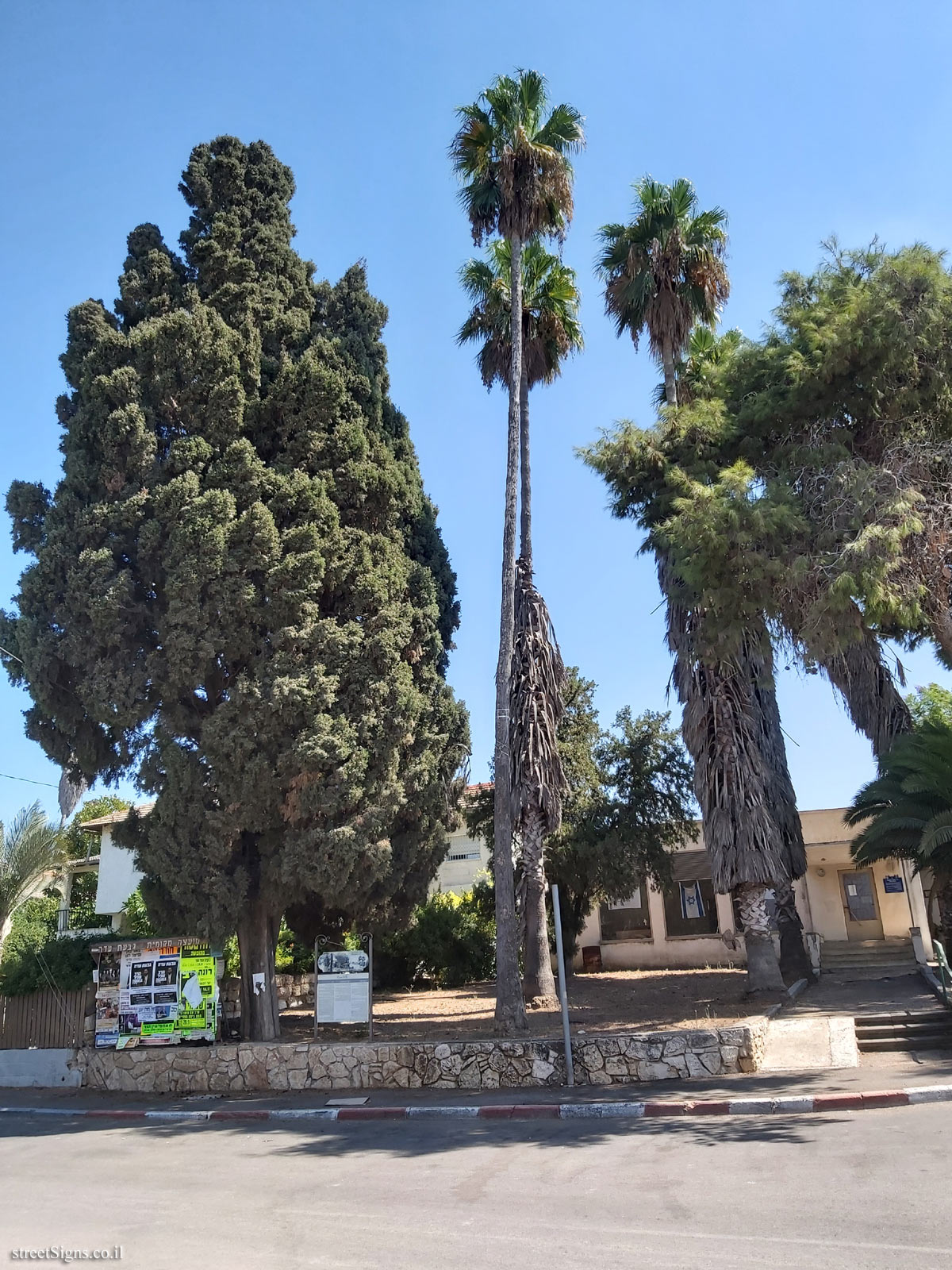The sign and some of the trees behind it were taken that day
 Click for a larger image Translation of the text on the sign
Click for a larger image Translation of the text on the sign:
Pictures of:
A pair of palm trees at the entrance to the house on HaDekel (Palm) Street
An olive tree more than a hundred years old on HaRishonim Street
Cypress view on HaRishonim Street
The symbol of the school Geva - Givat Ada
Symbol of the Dorot (Generations) Association
Emblem of the Binyamina - Givat Ada Local Council
Common Cypress Family: cypress, evergreen tree.
Fruits: Spherical pinecones
Distribution in Israel: Very common throughout the country, in settlements, planted forests and cemeteries.
Usage: An important forest tree that does not need watering. Used as a windbreaker - dense planting prevents strong winds from damaging agricultural crops. Also used for construction and ornamental. In folk medicine, cypress pine cones are used to treat diabetes, toothache and heartburn. Dip the pine cones in the water and use the tincture.
Sources: The tree is mentioned many times in the Bible as a symbol of freshness and power, sometimes in one breath with the cedar.
"the tall cedars thereof, and the choice cypress-trees" (Isaiah 37, 24)
"I am like a leafy cypress-tree" (Hosea, 12, 9) (the correct chapter is 14)
During the Second Temple period, cypress was used as a tree for construction, cypress trees were also used for the Temple building, floors, doors and walls. (Kings I, 6, 15)
When Herzl arrived in Israel, he planted a cypress in 1889.
On the tree in the colony in Givat Ada:
Planted in the Givat Ada colony around the central synagogue, the cemetery, in the yard of the first school of 1922 and around the "Geva" school. Cypress trees were planted as "windbreakers." On the east side of Geva School are cypress trees planted by the school’s students in the 1940s on the Feast of the Trees, on Tu B’Shvat.
Palm Washingtonia Family: Palm trees, evergreen tree up to 30 meters high, flowering occurs in early summer and another wave in autumn.
Distribution in Israel: An ornamental tree is common throughout the country. It is speculated that the first Washingtonians were brought to Israel by Aaron Aaronson and planted near his experimental farm in Atlit, this Washington Avenue still exists to this day and can be seen from the coastal road.
Uses: Ornamental wood in gardens, parks and streets.
On the tree in the colony in Givat Ada:
The palm trees were planted as early as the beginning of the settlement and they characterized Baron Rothschild’s colonies.
On each side of the entrance gate in the first houses two palm trees were planted during the 1920s and 1930s. The entrance street to the colony is named after them "Palm Street".
Olive Family: Olives, evergreen tree.
Flowering in April-May
Distribution in the country: A common tree, olives are grown all over the country, it is an ancient mountainous growth together with the almond, fig, vine and pomegranate.
Uses: Olive is used for edible, fruit oil is considered to be healthy in edible oils. Apart from the food, the olive oil is used for light and cosmetics (manufacture of cream soaps and more).
Olive oil has many uses in folk medicine, both for external use and ingestion. The olive stem is fine for carving ornaments and also for making furniture.
Sources: Many crowns have been associated with olives in sources: beauty, health, strength and stability, good name, worship, anointing of kings.
The olive is one of the seven species blessed with the Land of Israel and symbolizes honor and nobility. He was the first to be asked to reign in the trees in the "Yotam parable." The dove that came out of Noah’s check to "ease the water" back "at eventide; and lo in her mouth an olive-leaf freshly plucked" (Genesis 8, 11), the dove flew once and returned because she found no rest on her foot. The second time Noah sent, she came back with an olive leaf in her mouth. Says the Midrash, not for nothing, the dove chose to bring in a branch of the olive tree, as the olive leaf is very bitter and the dove comes to imply Noah (sings the dove in poetry chapters): says the dove before the Almighty "The sovereign of the world will be my food as bitter as olive in your hand and not sweet as honey by Meat and blood". The olive fruit is not eaten without care, and the oil produced from it has to do a lot of toil. Therefore, Israel has grown into olive (Yalkut Shimoni Jeremiah 247 289)" to tell you what olive does not take our name but by crush even Israel does not Return to the beneficiary except by torment..
The olive tree in the colony in Givat Ada:
In the early 1920s Baron de Rothschild donated 20 Syrian olive trees to each farmer for the household, the trees were planted by the farmers of the colony.
The information was written by students in the 73rd cycle of the "Geva" school as part of the "Research of the Colony" study and in collaboration with the "Generations" association and Gemach Loan and Savings.
Learn about:

 Click for a larger image
Click for a larger image